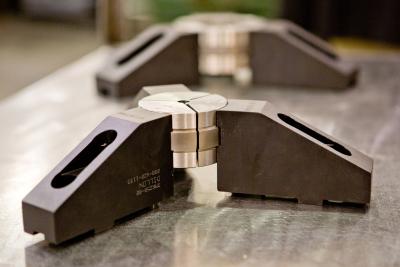
Collet pad top jaw systems from Dillon Manufacturing allow more aggressive machining to shorten cycle times while providing more consistent repeatability. Full contact of gripping surfaces provides a more stable grip and allows heavier cuts, while metal-to-metal fits ensure accuracy.
Round, hex, and square collet pad shapes with both smooth and serrated gripping surfaces available. The line includes collet pad top jaws and W&S solid emergency collet pads, as well as S-type, Gisholt, Jones & Lamson, and Martin collet pad types.
Dillon collet pads and jaws are suitable for precision boring, high-speed machining, tapping, drilling and finishing. They are especially suited for small-diameter machining of stems, spools, crimp assemblies, manifolds for high pressure air systems, medical parts, miscellaneous fittings, mechanical and transmission components and specialty valves.
All products are designed and manufactured by skilled and experienced engineers, using an integrated computer system tracks production, in ISO 9001:2015 facilities.
In addition to more aggressive machining, Dillon collet pad jaw systems increase a chuck’s range of workholding capabilities, allowing more varied part geometries to be machined with the same jaw system. They can convert through-hole chucks to hold small bar and tube stock. They can be changed quickly – often in just a few minutes – with just a jaw change, whereas changing the entire chuck may require several hours of labor.
Machinists using collet pad jaws can maximize their chuck capabilities and investment by taking advantage of both chuck and collet pad work, including the ability to run material that is hex or square in shape.
Contact Details
Related Glossary Terms
- boring
boring
Enlarging a hole that already has been drilled or cored. Generally, it is an operation of truing the previously drilled hole with a single-point, lathe-type tool. Boring is essentially internal turning, in that usually a single-point cutting tool forms the internal shape. Some tools are available with two cutting edges to balance cutting forces.
- chuck
chuck
Workholding device that affixes to a mill, lathe or drill-press spindle. It holds a tool or workpiece by one end, allowing it to be rotated. May also be fitted to the machine table to hold a workpiece. Two or more adjustable jaws actually hold the tool or part. May be actuated manually, pneumatically, hydraulically or electrically. See collet.
- collet
collet
Flexible-sided device that secures a tool or workpiece. Similar in function to a chuck, but can accommodate only a narrow size range. Typically provides greater gripping force and precision than a chuck. See chuck.
- tapping
tapping
Machining operation in which a tap, with teeth on its periphery, cuts internal threads in a predrilled hole having a smaller diameter than the tap diameter. Threads are formed by a combined rotary and axial-relative motion between tap and workpiece. See tap.
- through-hole
through-hole
Hole or cavity cut in a solid shape that connects with other holes or extends all the way through the workpiece.







